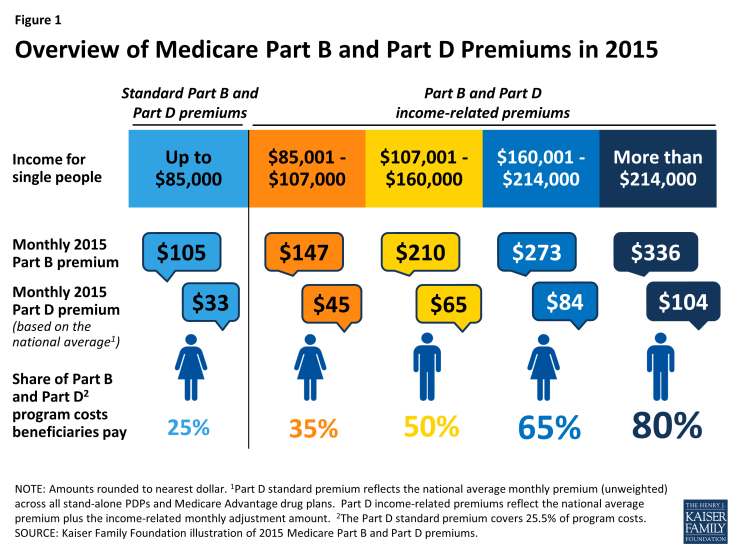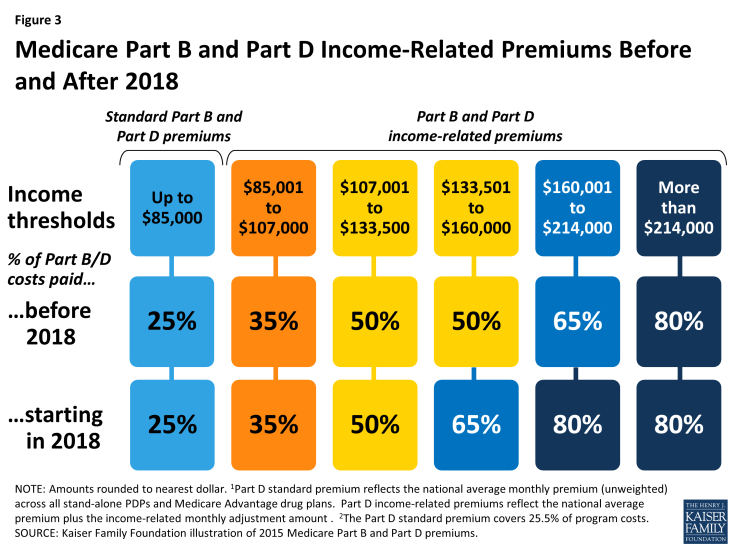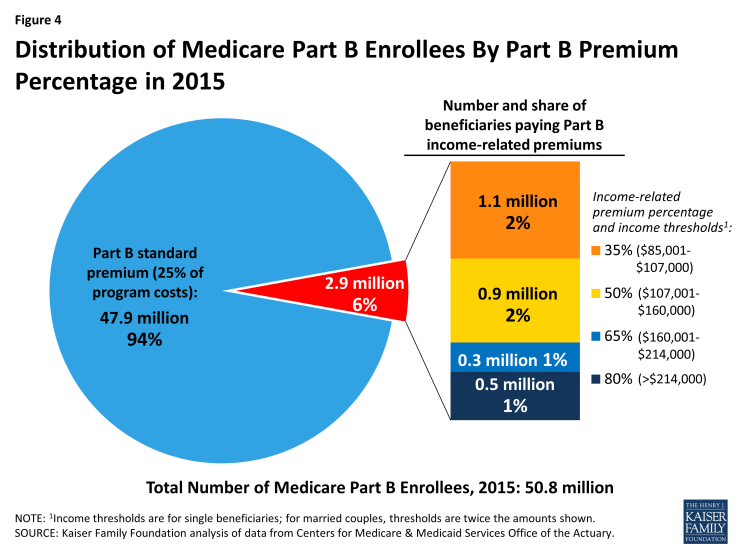Medicare’s Income-Related Premiums: A Data Note
The Medicare Access and CHIP Reauthorization Act of 2015 (MACRA)—a new law to repeal and replace Medicare’s Sustainable Growth Rate (SGR) formula for physician payments—includes a provision to increase Medicare premiums for some higher-income beneficiaries to help offset the cost of the law. The Congressional Budget Office estimated that this provision would increase Medicare’s premium revenues (and thereby reduce program spending) by $34.3 billion between 2018 and 2025.1 This idea is not a new one, having been raised in the context of earlier proposals to reduce federal spending and also included in the Obama Administration’s proposed budgets in recent years.2,3,4
This data note describes current requirements with respect to Medicare’s Part B and Part D income-related premiums, including the number and share of Medicare beneficiaries who are estimated to pay these premiums in 2015, the amount they pay, and the revenues raised from these premiums, based on data from the Centers for Medicare & Medicaid Services (CMS) Office of the Actuary (OACT). It also explains the recently enacted changes in MACRA that will affect some higher-income people on Medicare who are already paying income-related premiums, beginning in 2018.
Overview of Current Law Related to Medicare Premiums
Today, most Medicare beneficiaries pay the standard monthly premium, which is set to cover 25 percent of Part B and Part D program costs, but a relatively small share of beneficiaries (around 6 percent in 2015) with incomes above $85,000 for single people and $170,000 for married couples are required to pay higher premiums for Medicare Part B and Part D—ranging from 35 percent to 80 percent of program costs, depending on their incomes (Figure 1).
Part B and Part D Standard Premiums
Monthly premiums for most people on Medicare equal 25 percent of average per capita Part B expenditures for Part B enrollees and 25.5 percent of average per capita Part D expenditures for drug plan enrollees. In 2015, the Part B standard monthly premium is $104.90; for Part D, the national average monthly premium, according to CMS, is $33.13.5 Actual monthly premiums for stand-alone prescription drug plans vary across plans and regions from a low of $12.60 to a high of $171.90 in 2015.6
Income-related Premiums for Part B and Part D
People on Medicare with incomes above $85,000 for individuals and $170,000 for couples are required to pay higher premiums for Medicare Part B and Part D. The Part B income-related premium was established by the Medicare Modernization Act of 2003 and took effect in 2007. The Part D income-related premium was established by the Affordable Care Act of 2010 (ACA) and took effect in 2011. Under these provisions, beneficiaries with higher incomes pay a larger share of Part B and Part D program costs than 25 percent, ranging from 35 percent to 80 percent of per capita costs, depending on their income.
In 2015, Part B premiums for higher-income beneficiaries range from $147 per month for individuals with annual incomes above $85,000 up to $107,000, to $336 per month for individuals with incomes above $214,000. For Part D, higher-income beneficiaries pay a monthly premium surcharge in addition to the premium for their specific Part D plan; in 2015, the monthly premium surcharge ranges from around $12 for individuals with annual income above $85,000 up to $107,000, to an additional $71 for individuals with incomes above $214,000. When combined with the national average premium amount, higher-income Part D enrollees pay between $45 and $104 per month in 2015.
For beneficiaries enrolled in both Part B and Part D, the combined monthly premiums (based on the standard Part D premium) increase with income, ranging from $138 (25 percent of program costs) for single beneficiaries with incomes up to $85,000, to $440 (80 percent of program costs) for beneficiaries with incomes above $214,000 (Figure 2). Monthly premiums for married couples who are both enrolled in Part B and Part D are twice these amounts, ranging from $276 for those with incomes up to $170,000, to $880 for couples with incomes above $428,000.
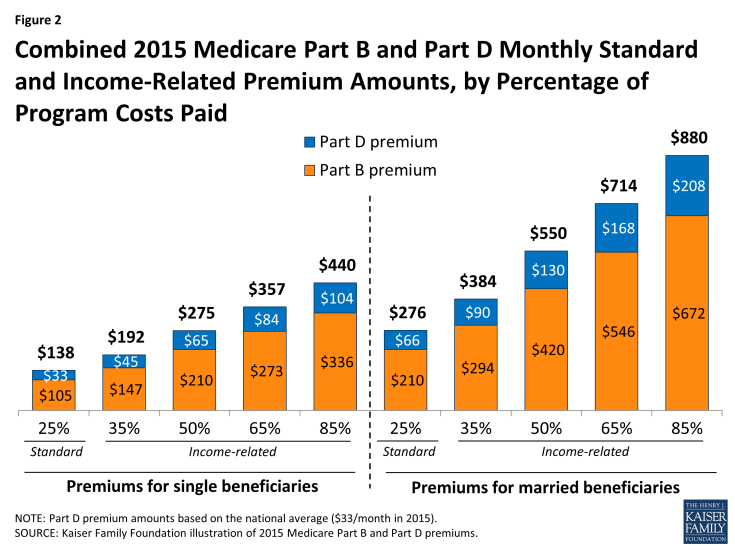
Figure 2: Combined 2015 Medicare Part B and Part D Monthly Standard and Income-Related Premium Amounts, by Percentage of Program Costs Paid
The recent changes to Medicare’s income-related premiums will affect beneficiaries with incomes above $133,500 ($267,000 for married couples) by requiring them to pay a larger percentage of Part B and Part D program costs than they currently pay, beginning in 2018 (Figure 3):
- Beneficiaries with incomes above $133,500 and up to $160,000 ($267,000-$320,000 for married couples) will pay 65 percent of Part B and Part D program costs starting in 2018, up from 50 percent prior to 2018. As a result of this change, monthly Part B premiums are expected to be $310 in 2018 for beneficiaries in this income group, rather than $238 that year, based on projections of Part B program costs from the Medicare Trustees.7
- Beneficiaries with incomes above $160,000 and up to $214,000 ($320,000-$428,000 for married couples) will be required to pay 80 percent of Part B and Part D program costs, rather than 65 percent. As a result of this change, monthly Part B premiums in 2018 are expected to be $381 for beneficiaries in this income group, rather than $310 that year, based on projections from the Medicare Trustees.
The law did not change premium payments for beneficiaries with incomes above $214,000, who already are required to pay 80 percent of Part B and Part D program costs.
How Many Medicare Beneficiaries Pay Part B and Part D Income-related Premiums in 2015?
Part B
In 2015, an estimated 6 percent (2.9 million) of the 50.8 million Medicare beneficiaries who are enrolled in Part B pay income-related premiums (Figure 4). Of these 2.9 million Part B enrollees:
- 1.1 million beneficiaries with incomes above $85,000 up to $107,000 ($170,000 to $214,000 for married couples) pay 35 percent of Part B program costs;
- 0.9 million beneficiaries with incomes above $107,000 up to $160,000 ($214,000 to $320,000 for married couples) pay 50 percent of Part B program costs;
- 0.3 million beneficiaries with incomes above $160,000 up to $214,000 ($320,000 to $428,000 for married couples) pay 65 percent of Part B program costs; and
- 0.5 million beneficiaries with incomes above $214,000 ($428,000 for married couples) pay 80 percent of Part B program costs.
Part D
In 2015, an estimated 5 percent of the 42.2 million Medicare beneficiaries enrolled in Part D plans pay higher income-related amounts in addition to their specific Part D plan monthly premium amounts. Fewer beneficiaries pay the Part D income-related premium than that for Part B because fewer beneficiaries are enrolled in Part D plans than in Part B.
Of the 2.1 million Part D enrollees who pay the Part D income-related premium:
- 0.8 million (2 percent of all Part D enrollees) pay 35 percent of Part D program costs;
- 0.7 million (2 percent of all Part D enrollees) pay 50 percent of Part D program costs;
- 0.2 million (1 percent of all Part D enrollees) pay 65 percent of Part D program costs; and
- 0.4 million (1 percent of all Part D enrollees) pay 80 percent of Part D program costs.
Trends in the Share of Beneficiaries Paying Income-Related Premiums
For the first few years that the Medicare Part B income-related premium was in effect (between 2007 and 2010), the income thresholds that determined who paid the higher amounts were set to increase annually with the rate of inflation so that about 5 percent of Part B enrollees would pay the income-related premium. Since 2011, however, the income thresholds that determine who pays the higher Part B premiums have been fixed at their current levels through 2019 (a provision of the ACA); this provision also applies to Part D. As a result, the number and share of beneficiaries paying the Part B and Part D income-related premiums has increased since 2011, and is projected to continue to increase through 2019 (Figures 5 and 6). For example:
- The share of beneficiaries paying the Part B income-related premium has increased from 3.5 percent in 2011 to 5.7 percent in 2015; the share is projected to rise further to 8.3 percent of enrollees by 2019.
- Similarly for Part D, the share of beneficiaries paying the income-related premium has increased from 2.4 percent of enrollees in 2011 to 5.1 percent in 2015, and is projected to increase further to 7.6 percent of Part D enrollees in 2019.
- In 2020 and subsequent years, the income thresholds will once again be indexed to inflation, based on their levels in 2019 (a provision in MACRA). As a result, the number and share of beneficiaries paying income-related premiums will increase as the number of people on Medicare continues to grow in future years and as their incomes rise.
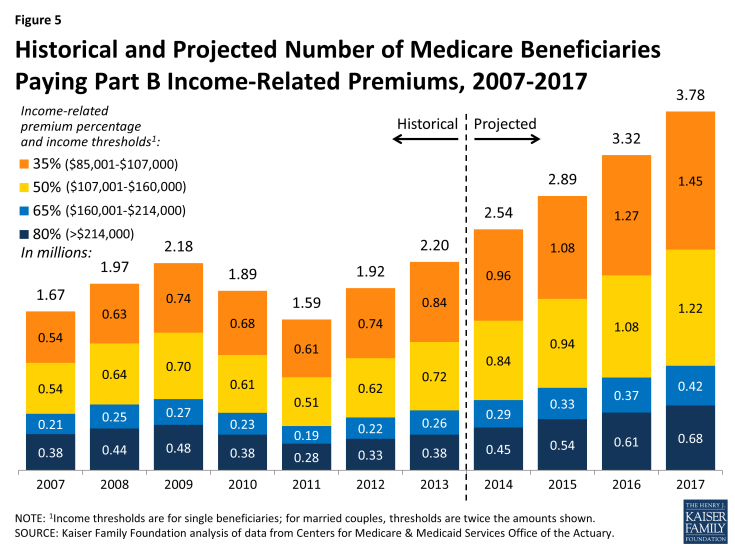
Figure 5: Historical and Projected Number of Medicare Beneficiaries Paying Part B Income-Related Premiums, 2007-2017
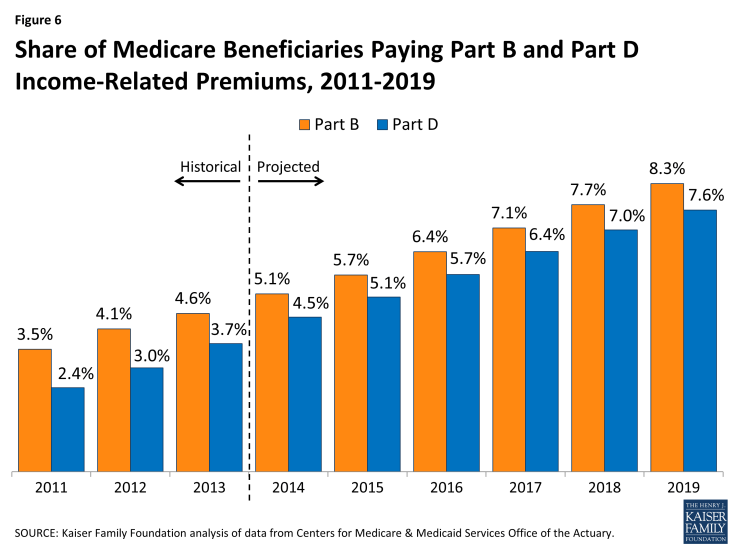
Figure 6: Share of Medicare Beneficiaries Paying Part B and Part D Income-Related Premiums, 2011-2019
How Much Do Medicare’s Income-Related Premiums Contribute to Total Part B and Part D Premium Collections?
Of the projected $67 billion in total Part B premium collections in 2015, 6 percent, or $4 billion, will be paid by higher-income beneficiaries in the form of Part B income-related premiums, according to OACT. Income-related premiums paid by Part B enrollees with incomes between $85,000 and $160,000 (70 percent of those paying higher premiums) account for roughly 44 percent of the Part B income-related premium receipts, while premiums paid by Part B enrollees with incomes above $214,000 (19 percent of those paying higher premiums) account for 39 percent of additional premium income (Figure 7).
The picture is similar for Part D. OACT has estimated that Part D premium collections will total approximately $13 billion in 2015. Of this total, 7 percent, or $1 billion, will be paid by higher-income beneficiaries in the form of Part D income-related premiums.
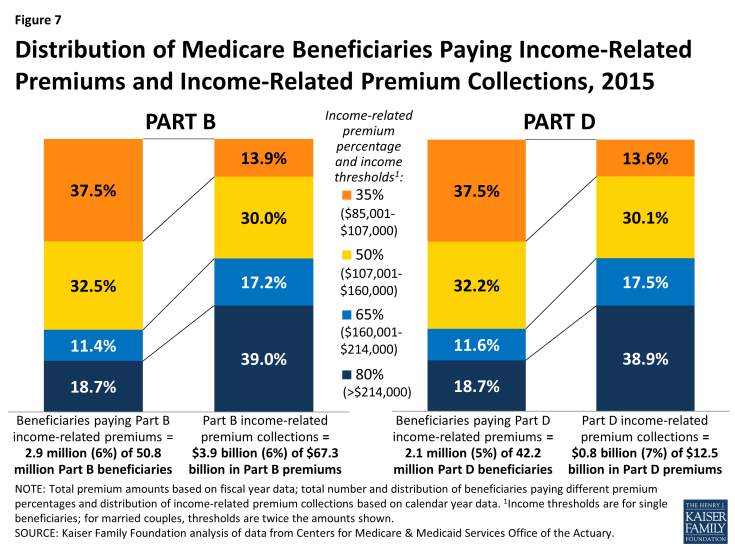
Figure 7: Distribution of Medicare Beneficiaries Paying Income-Related Premiums and Income-Related Premium Collections, 2015
Policy Implications
Increasing premiums for some beneficiaries who are already subject to income-related premiums will affect a relatively small but growing share of the Medicare population. Based on our estimates, the recently enacted provisions that increase Part B and Part D income-related premium percentages for beneficiaries with incomes above $133,500 up to $214,000 ($267,000 to $428,000 for married couples) beginning in 2018, would affect around 2 percent of beneficiaries if it were implemented this year.
Part of the appeal of requiring higher-income beneficiaries to pay a greater share of Medicare costs is that these higher costs are imposed on only a relatively small share of beneficiaries who arguably have greater financial means to bear the additional expenses, thereby protecting the majority of people on Medicare with relatively modest incomes. At the same time, there is some concern that the income thresholds used to trigger the payment of higher premiums by Medicare beneficiaries ($85,000 for individuals and $170,000 for couples) are lower than the thresholds used to define higher-income people in other policy discussions. Tracking the effects on beneficiaries of these higher income-related premiums, including whether they affect Part B and Part D participation rates, will be important for understanding the implications of these and similar changes moving forward.
Endnotes
Congressional Budget Office, Cost Estimate and Supplemental Analyses for H.R. 2, the Medicare Access and CHIP Reauthorization Act of 2015, March 25, 2015.
J. Cubanski, T. Neuman, G. Jacobson, and K.E. Smith, "Raising Medicare Premiums for Higher-Income Beneficiaries: Assessing the Implications," Kaiser Family Foundation, January 2014. Available at https://www.kff.org/medicare/issue-brief/income-relating-medicare-part-b-and-part/.
Office of Management and Budget, The Budget of the United States Government, Fiscal Year 2016, February 2015.
G. Jacobson, C. Boccuti, J. Cubanski, C. Swoope, and T. Neuman, "Summary of Medicare Provisions in the President’s Budget for Fiscal Year 2016," Kaiser Family Foundation, February 2015. Available at https://www.kff.org/medicare/issue-brief/summary-of-medicare-provisions-in-the-presidents-budget-for-fiscal-year-2016/.
CMS, “Annual Release of Part D National Average Bid Amount and other Part C & D Bid Information,” July 31, 2014.
Kaiser Family Foundation, “The Medicare Prescription Drug Benefit Fact Sheet," September 2014. Available at https://www.kff.org/medicare/fact-sheet/the-medicare-prescription-drug-benefit-fact-sheet/.
2014 Annual Report of the Boards of Trustees of the Federal Hospital Insurance and Federal Supplementary Medical Insurance Trust Funds, July 2014.

